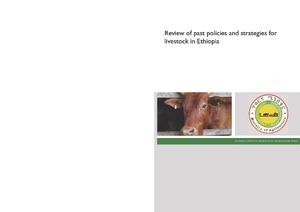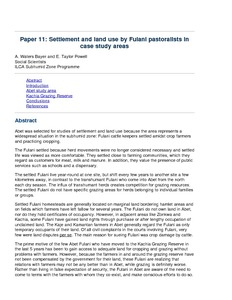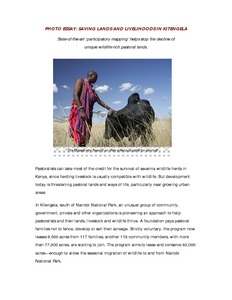Rift Valley fever in Kenyan pastoral livestock: Simulation with an individual-based demographic model
Rift Valley Fever (RVF) is a viral zoonosis and a mosquito-borne disease caused by a phlebovirus in the family Bunyaviridae. It affects livestock, humans and wildlife. Epidemic outbreaks of RVF in East Africa, which occur after heavy rainfalls in cycles of 5-15 years, have caused next to human morbidity and mortality considerable economic losses throughout the livestock production and market chain. Establishment of a pastoral livestock demographic model simulating alternating normal and drought periods (appropriate for the Sahel) and RVF epidemics.
Risk factors for sero-prevalence of tick-borne diseases of calves in Maasai pastoral herds in Kajiado District, Kenya
Scope for improvement of small ruminant production in the Sahel
This chapter investigates the options for improving the performance of small ruminants interms of their contribution to household incomes. The characteristics of the existing production system are first sketched in order to identify the resource requirements and constraints of the system. Based on this imformation, a steady-state flock model is then developed and used to assess the impact of variation in growth, reproduction and mortality rates production.
Small ruminant research and development in Africa: proceedings of the Third Biennial Conference of the African Small Ruminant Research Network : UICC, Kampala, Uganda, 5-9 December 1994
This volume contains papers and abstracts of the Third Biennial Conference of the African Small Ruminant Research Network. In addition to the keynote address, there are nine papers on Genetic Resources Enhancement and Utilisation, seven papers on Production Systems, Policy and Economics, six papers on Management and Health, 12 papers and Feeding Systems and 10 papers on Performance and Reproduction. Six poster abstracts covering the above topics add to the volume.
Settlement and land use by Fulani pastoralists in case study areas
Presents results of studies of settlement, land use & relations w. settled farmers of Fulani agropastoralists in Abet & Kachia Grazing Reserve in Subhumid Nigeria. Discusses reasons of choice of site, pattern & right of grazing and access to land.
Spatial correlates of land-use changes in the Maasai-Steppe of Tanzania: Implications for conservation and environmental planning
Spatially explicit models are becoming increasingly important tools for simulating land-use change. In this study, we formulated and tested models that incorporated spatial correlates of agricultural expansion and used them to predict local- and landscape-scale patterns of agricultural land-use change and its implications in the Maasai-Steppe of Northern Tanzania. We evaluated the relationship between agricultural land-use and its spatial correlates using Multiple Logistic Regression on data derived from satellite imageries for the year 2000.
Spatial modeling the impact of livestock grazing, fire management and wood cutting on the structure of savana woodland vegetation
Social organization and water control among the Borana of southern Ethiopia
Description of the socioeconomic organization of the Borana pastoralists with particular reference to the Gada System and the traditional well organization.
Socio-economic characteristics and perceptions of cattle keepers and constraints to cattle production in western Kenya
A cross-sectional survey was done in two Districts in Western Kenya to determine the socio-economic characteristics and perceptions of the cattle types kept. This involved socio-economic profiles of households, herd structure, reasons for keeping specific types of cattle and production and marketing constraints together with desired policy interventions to address the constraints. A total of 210 farmers randomly selected were interviewed. The data was analysed using Statistical Analysis System program. The majority of farmers (84%) were males.







